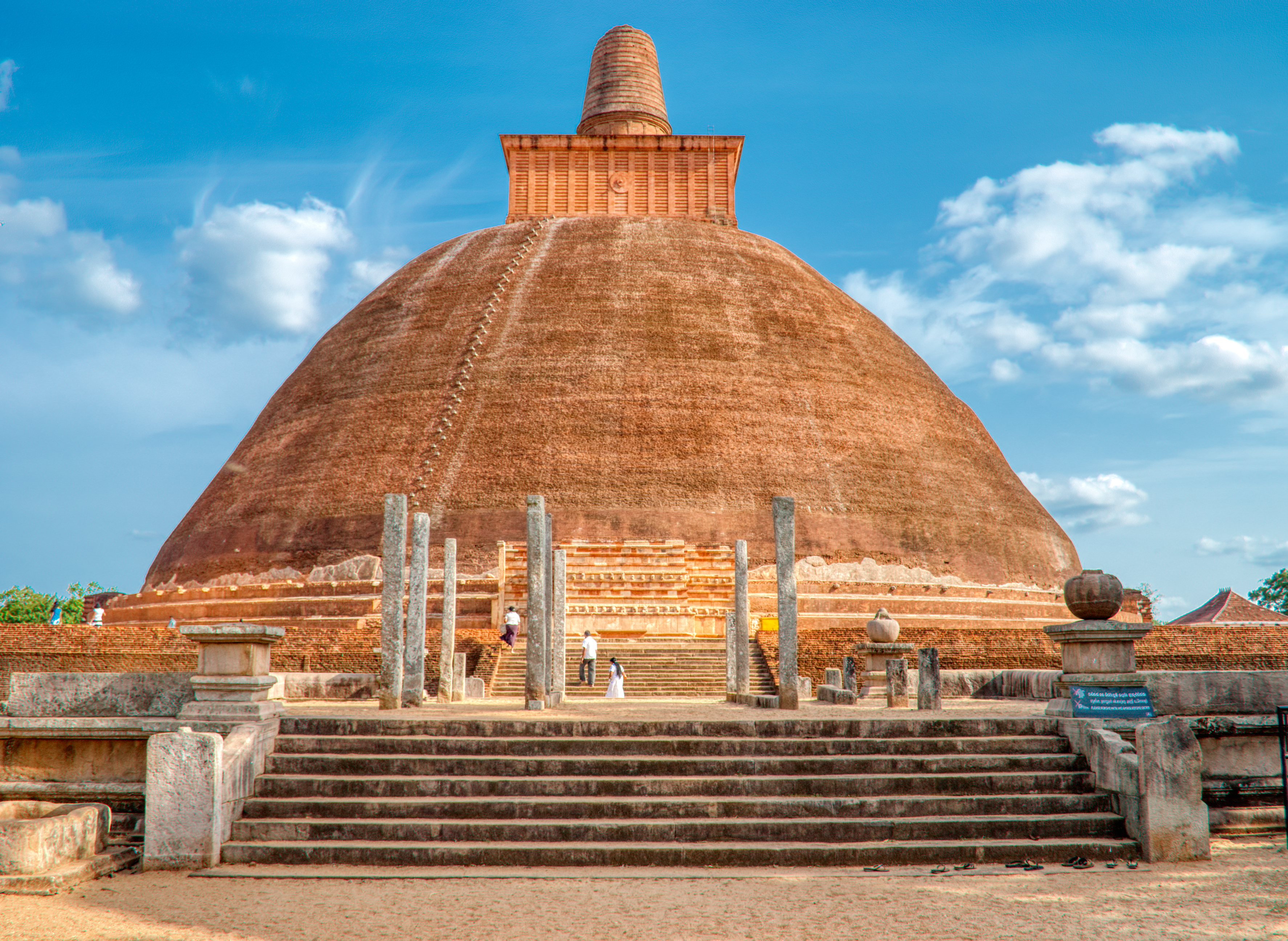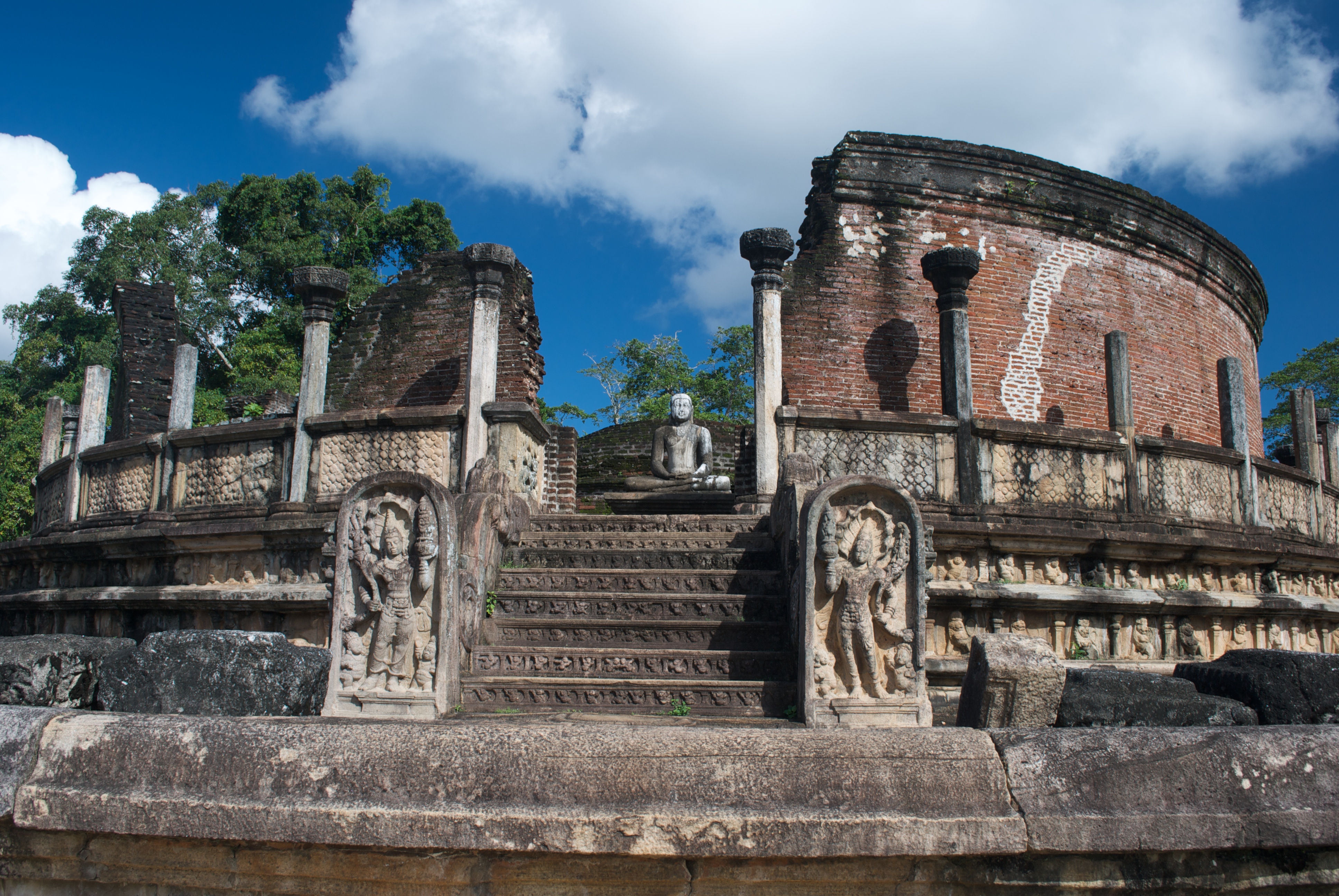|
Vatadage
A vaṭadāge () is a type of Buddhist structure found in Sri Lanka. It also known as a ''dage'', ''thupagara'' and a ''cetiyagara''. Although it may have had some Indian influence, it is a structure that is more or less unique to the architecture of ancient Sri Lanka. Vatadages were built around small stupas for their protection, which often enshrined a relic or were built on hallowed ground. Circular in shape, they were commonly built of stone and brick and adorned with elaborate stone carvings. Vatadages may have also had a wooden roof, supported by a number of stone columns arranged in several concentric rows. Only ten vatadages now remain in Sri Lanka. The builders of many of these monuments are unknown, as are their time of creation. The oldest such construction is believed to be the one surrounding the Thuparamaya. The best example of a vatadage is generally believed to be the Polonnaruwa Vatadage. Along with it, the vatadages at Medirigiriya Vatadage, Medirigiriya and Giriha ... [...More Info...] [...Related Items...] OR: [Wikipedia] [Google] [Baidu] |
Architecture Of Ancient Sri Lanka
The architecture of ancient Sri Lanka displays a rich diversity, varying in form and architectural style from the Anuradhapura Kingdom (377 BC–1017) through the Kingdom of Kandy (1469–1815). Sinhalese architecture also displays many ancient North Indian influences. Buddhism had a significant influence on Sri Lankan architecture after it was introduced to the island in the 3rd century BC, and ancient Sri Lankan architecture was mainly religious, with more than 25 styles of Buddhist monasteries.Pieris K (2006), Architecture and landscape in ancient and medieval Lanka Significant buildings include the stupas of Jetavanaramaya and Ruwanvelisaya in the Anuradhapura kingdom and further in the Polonnaruwa kingdom (11th–13th centuries). The palace of Sigiriya is considered a masterpiece of ancient architecture and ingenuity, and the fortress in Yapahuwa and the Temple of the tooth in Kandy are also notable for their architectural qualities. Ancient Sri Lankan architecture is also s ... [...More Info...] [...Related Items...] OR: [Wikipedia] [Google] [Baidu] |
Polonnaruwa Vatadage
The Polonnaruwa Vatadage is an ancient structure dating back to the Kingdom of Polonnaruwa of Sri Lanka. It is believed to have been built during the reign of Parakramabahu I to hold the Relic of the tooth of the Buddha or during the reign of Nissanka Malla of Polonnaruwa to hold the alms bowl used by the Buddha. Both these venerated relics would have given the structure a great significance and importance at the time. Located within the ancient city of Polonnaruwa, it is the best preserved example of a vatadage in the country, and has been described as the "ultimate development" of this type of architecture. Abandoned for several centuries, excavation work at the Polonnaruwa Vatadage began in 1903. Built for the protection of a small stupa, the structure has two stone platforms decorated with elaborate stone carvings. The lower platform is entered through a single entrance facing the north, while the second platform can be accessed through four doorways facing the four cardinal p ... [...More Info...] [...Related Items...] OR: [Wikipedia] [Google] [Baidu] |
Thuparama
Thuparamaya is the earliest documented Buddhist temple in Sri Lanka. Its building dates to the arrival of Mahinda (Buddhist monk), Mahinda Thera (Mahindagamanaya) and the introduction of Buddhism to the island. Located within the sacred precinct of Mahamevnāwa Gardens, Mahamewna park, the Thuparamaya Stupa is the earliest Dagoba to be constructed on the island, dating back to the reign of King Devanampiya Tissa (247-207 BC). The temple has been recognised by the Government of Sri Lanka, Government and listed as a protected List of Archaeological Protected Monuments in Sri Lanka, archaeological site in Sri Lanka. History Thuparamaya is closely linked to Mahinda (Buddhist monk), Mahinda Thera, the envoy sent by King Ashoka to Sri Lanka, bringing Theravada Buddhism and Chaitya worship to the island. At Mahinda's request, King Devanampiya Tissa built Thuparamaya to enshrine the right collar-bone of the Gautama Buddha, Buddha, thus the claim to be the first stupa built in Sri Lanka. ... [...More Info...] [...Related Items...] OR: [Wikipedia] [Google] [Baidu] |
Thuparamaya
Thuparamaya is the earliest documented Buddhist temple in Sri Lanka. Its building dates to the arrival of Mahinda Thera (Mahindagamanaya) and the introduction of Buddhism to the island. Located within the sacred precinct of Mahamewna park, the Thuparamaya Stupa is the earliest Dagoba to be constructed on the island, dating back to the reign of King Devanampiya Tissa (247-207 BC). The temple has been recognised by the Government and listed as a protected archaeological site in Sri Lanka. History Thuparamaya is closely linked to Mahinda Thera, the envoy sent by King Ashoka to Sri Lanka, bringing Theravada Buddhism and Chaitya worship to the island. At Mahinda's request, King Devanampiya Tissa built Thuparamaya to enshrine the right collar-bone of the Buddha, thus the claim to be the first stupa built in Sri Lanka. It also marks the formal arrival of Buddhism. The name Thuparamaya comes from "stupa" and "aramaya" which is a residential complex for monks. According to the Pa ... [...More Info...] [...Related Items...] OR: [Wikipedia] [Google] [Baidu] |
Medirigiriya Vatadage
Medirigiriya Vatadageya () is a Buddhist structure (Vatadage) in Medirigiriya, Sri Lanka. The structure has been formally recognised by the Government as an Archaeological Protected Monument. History Constructed during the Anuradhapura era, this is believed to be the ancient Mandalagiraka Vihara to which King Kanittha Tissa added an Uposathaghara (a chapter house). 3D documentation The site was documented in 3D in 2019 by the Zamani Project. See also * Polonnaruwa Vatadage * Vatadage A vaṭadāge () is a type of Buddhist structure found in Sri Lanka. It also known as a ''dage'', ''thupagara'' and a ''cetiyagara''. Although it may have had some Indian influence, it is a structure that is more or less unique to the architecture ... References Archaeological protected monuments in Polonnaruwa District Tourist attractions in North Central Province, Sri Lanka Vatadages {{NorthCentralLK-geo-stub ... [...More Info...] [...Related Items...] OR: [Wikipedia] [Google] [Baidu] |
Vasabha
Vasabha ( Sinhala: ) was a monarch of the Anuradhapura period of Sri Lanka. He is considered to be the pioneer of the construction of large-scale irrigation works and underground waterways in Sri Lanka to support paddy cultivation. 11 reservoirs and 12 canals were constructed during his reign. He also constructed several Buddhist temples in addition to renovating already existing ones. Vasabha started a new dynasty in the history of Sri Lankan monarchs, having seized the throne after killing Subharaja, the then ruler of Anuradhapura. Early life and kingship Prince Vasabha, born to a family of a clan named Lambakanna, spent his childhood in a village in the North of the country working for his uncle who was a general in the king's army. The ruler of the country at this time was Subharaja, who was informed by soothsayers that one named Vasabha would defeat him and become king. To avoid this, Subharaja ordered everyone in the country bearing that name to be killed. Vasabha's uncle t ... [...More Info...] [...Related Items...] OR: [Wikipedia] [Google] [Baidu] |
Lankarama
Lankarama is a stupa built by King Valagamba, in an ancient place at Galhebakada in the ancient kingdom of Anuradhapura, Sri Lanka. Nothing is known about the ancient form of the stupa, and later this was renovated. The ruins show that there are rows of stone pillars and it is no doubt that there has been a house built encircling the stupa ( vatadage) to cover it. The round courtyard of the stupa seems to be above the ground. The diameter of the stupa is . The courtyard is circular in shape and the diameter is . Eth pokuna The eth pokuna (elephant pond) is an ancient man-made pond situated close to Lankaramaya. It is in length, in width and deep, with a holding capacity of of water. The water to this pond is supplied from the Periyamkulama Tank through a network of underground canals. These underground canals still work after several hundreds years. This tank was probably used by the monks in the Abhayagiri vihāra Abhayagiri may refer to: * Abhayagiri vihāra a ruined ... [...More Info...] [...Related Items...] OR: [Wikipedia] [Google] [Baidu] |
Anuradhapura
Anuradhapura (, ; , ) is a major city located in the north central plain of Sri Lanka. It is the capital city of North Central Province, Sri Lanka, North Central Province and the capital of Anuradhapura District. The city lies north of the current capital of Colombo in the North Central Province, on the banks of the historic Malwathu Oya. The city is now a World Heritage Site famous for its well-preserved ruins of the ancient Sinhala Kingdom, Sinhalese civilisation. While ''Mahāvaṃsa'' places the founding of the city in 437 BCE, the site has been inhabited for much longer, making it a major human settlement on the island for almost three millennia and one of the List of oldest continuously inhabited cities, oldest continuously occupied cities in Asia. It is the cradle of the Hydraulic Sinhalese civilisation, Theravada Buddhism, and the longest-serving List of capitals in Sri Lanka, ancient capital of Sri Lanka that has survived for 1500 years. Moreover, it was the first capi ... [...More Info...] [...Related Items...] OR: [Wikipedia] [Google] [Baidu] |
Gothabhaya Of Sri Lanka
Gothabhaya, also known as Meghavannabhaya, Gothakabhaya and Goluaba, was a king of the Anuradhapura Kingdom of Sri Lanka whose reign lasted from 254 to 267. During his reign, Gothabhaya renovated several temples and monasteries and also built a new temple. He is the last of three princes who seized the throne from King Vijaya Kumara and ruled the country. He is known for banishing 60 Buddhist monks who followed teaching contradictory to Theravada, and also for rebelling against his friend Samghabodhi to seize the throne himself. Legacy Gothabhaya had two sons named Jetthatissa and Mahasena. He entrusted the education of his sons to a South Indian monk named Sanghamitta who had befriended him. This turned out to be a key point in Sri Lankan history since Mahasena, who had embraced the Vaitulya doctrines taught by Sanghamitta, constructed the Jetavana temple which became one of the country's three main schools of Buddhism during the Anuradhapura period despite Gothabhaya's effo ... [...More Info...] [...Related Items...] OR: [Wikipedia] [Google] [Baidu] |
Mihintale
Mihintale is a mountain peak near Anuradhapura in Sri Lanka. It is believed by Sri Lankans to be the site of a meeting between the Buddhist monk Mahinda (buddhist monk), Mahinda and King Devanampiyatissa which inaugurated the presence of Buddhism in Sri Lanka. It is now a pilgrimage site, and the site of several religious monuments and abandoned structures. History Approximately east of Anuradhapura, close to the Anuradhapura - Trincomalee Road is situated the "Missaka Pabbata" which is in height and is one of the peaks of a mountainous range. According to Dipavamsa and Mahavamsa, Thera Mahinda (buddhist monk), Mahinda came to Sri Lanka from India on the full moon day of the month of Poson (June) and met King Devanampiyatissa and preached the Buddhist doctrine. The traditional spot where this meeting took place is revered by the Buddhists of Sri Lanka. Therefore, in the month of Poson, Buddhists make their pilgrimage to Anuradhapura and Mihintale. Mahinda was the son of E ... [...More Info...] [...Related Items...] OR: [Wikipedia] [Google] [Baidu] |






